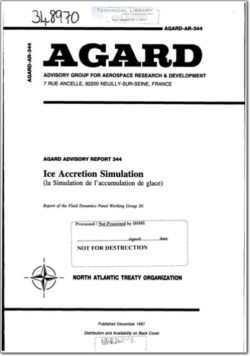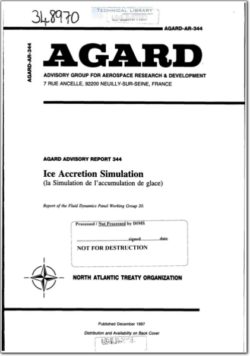AGARD-AR-344

- Version
- 321 Downloads
- 49.80 MB File Size
- 1 File Count
- March 8, 2016 Create Date
- March 8, 2016 Last Updated
Ice Accretion Simulation

Ice Accretion Simulation is an important issue for flight safety. Every year several incidents happen which can be
associated with severe icing problems. Although the bulk of them may be due to human mistakes during flight in
icing conditions, some cases remain which are consequences of icing conditions never observed before or of
failures not foreseen. Therefore icing has always attracted great interest from aircraft manufacturers, authorities
responsible for certification and many researchers.
Since aircraft icing is important for both civil and military aircraft, it has been the subject of many AGARD
publications. In particular the Fluid Dynamics Panel (FDP) is engaged in the fluid mechanics aspects of ice
accretion that include the fluid flow and thermal mechanisms of accreting ice as well as the flow around aircraft
components contaminated by ice. Both perspectives are addressed in this report and the primary aim of the work
is to present the guidance that fluid mechanics can contribute towards attainment of safe flight under icing
conditions and for corresponding certification and qualification efforts.
In the FDP, icing problems were last addressed in a Specialists Meeting on ‘Effects of Adverse weather on
Aerodynamics’ in Toulouse, 1991. Following that meeting a Working Group on ‘Ice Accretion Simulation’ was
proposed in the same year and was approved in 1993 as FDP Working Group 20. It started working in Spring
1994. The scope of the work has mainly been restricted to the above mentioned fluid dynamic aspects of the topic
and therefore the objectives are:
(i) Critical evaluation of aircraft performance degradation and of certification demands, including design
recommendations
(ii) Enhancements and verification of experimental techniques, ice test facilities and similarity laws
(iii) Review, validations, and progress of ice accretion prediction codes
(iv) New look at the data base of critical atmospheric conditions
The report covers the effects of ice accretion on wings, tail surfaces, engine inlets, and rotary wings.
Experimentally, besides the capability of icing wind tunnel facilities, the problems of spray tanker aircraft
experiments are considered, the related similarity laws are examined and the techniques for measuring droplet
size and distribution are reviewed. The basic factors influencing computational predictions are discussed in detail,
especially those not completely known up to now as for example surface roughness and surface head transfer. In
addition to the 2D prediction methodology, the status of extensions to 3D is presented. An essential aim of a
planned follow-on activity should be to establish some well-documented reference cases by suitable in-flight
experiments and to calibrate prediction tools and also experimental facilities and techniques for those reference
cases. The overall goal is to improve reliability and to reduce efforts and costs in the aircraft
certification/qualification procedure.
| File | Action |
|---|---|
| AGARD-AR-344 Ice Accretion Simulation.pdf | Download |
Comment On This Post